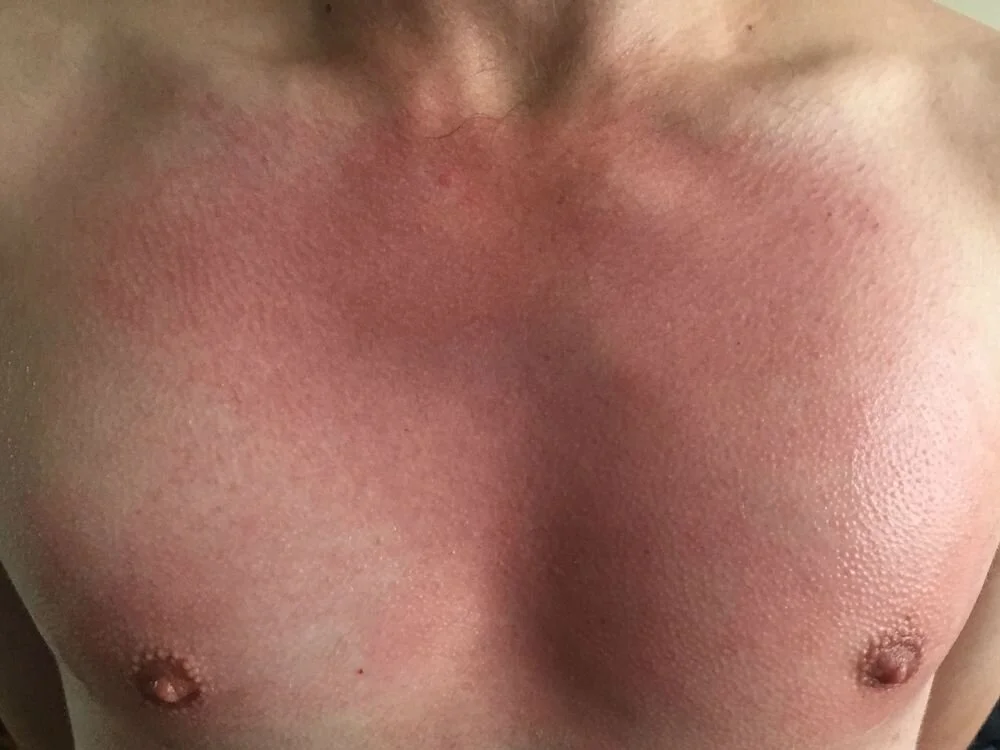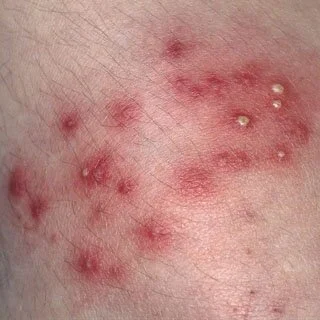
Possible Skin Reactions
possible skin reactions from
Waxing & Sugaring
During the hair removal process, our bodies experience a certain level of trauma. Don’t let that scare you! The results that we get from waxing are worth it. We are damaging the hair follicles, causing hair to grow back slower. The stress that hair removal can induce on your body may occasionally cause some different reactions to the skin.
Extreme skin reactions from waxing or sugaring are not common, but they do happen, and we should know what to expect and how to treat them. Hello Sugar’s Aestheticians are highly trained in skincare treatment and know what to do in the case of a reaction. Should you have a reaction of any sort, it is important to let us know immediately and we will educate you to know exactly what to do.
Common Reactions
Histamine Reactions
Ingrown Hair
Redness
Perifolliccular Edema
Bacterial Infection
Redness
What is it?
Wax is warm, therefore the heat can cause the skin to turn pink or red. This is more pronounced in the skin that is pale and considered reactive.
How long does it last?
This reaction is very temporary. Reactive skin is simply defined as skin that responds to stimulus. If your skin is red solely from the change in temperature, it will dissipate quickly.
How to treat it?
A cooling and soothing gel is applied right after treatment in the salon. Aloe Vera or other soothing botanicals can also be applied at home.
Histamine Reaction
What is it?
First off, experiencing a histamine reaction does not mean that you are allergic to the wax or sugar product. Creating histamine is one way the body protects itself against the stress of a perceived attack. A histamine reaction is easily identified by a rash that presents itself as welts or bumps. This reaction may happen immediately after your wax or sugar. Histamine is very helpful and it works by enlarging the blood vessels and making them easier to penetrate. The body then swells and protects the affected area. It is the increase in the size of the blood vessels that also additionally creates erythema, which is reddening of the skin.
How long does it last?
Histamine reactions generally only last a few hours.
How to treat it?
Not everyone will experience a histamine reaction, but if you do, it has been our experience that it can be treated either with an antihistamine cream (such as Benadryl) or by taking an antihistamine orally before your wax. We have learned that if an antihistamine cream is applied directly after treatment, the discomfort can be greatly reduced. Feel free to bring the cream with you to your appointment and have the aesthetician apply it. If you are someone who seeks a more natural approach, Lavender is an essential oil with anti-inflammatory properties, and it’s gentle enough that it can be applied to the skin. Please be advised that the more consistent you are with your waxing regimen, the less likely you'll be to experience histamine reactions (a great way to stay consistent is our membership program!)
Ingrown Hair
What is it?
Ingrown hair occurs when the hair below the skin’s surface isn’t able to exit the skin’s surface. The hair continues to grow underneath the surface.
We classify ingrown hairs into three levels of severity
Light
Hair appearing just below the surface of the skin. Treat with mechanical exfoliation and tweezers. Typically lasts a few days.
Medium
Ingrown hairs are deep and cause swelling around the infected area. Treat with mechanical and chemical exfoliation. Supplement with the Perfect Peach treatment if needed. Typically lasts 1-2 weeks but may last longer if not properly treated.
Severe
Ingrown hair occurs frequently and in multiple areas beneath the skin’s surface. If left untreated, there may be a hardening of the skin above the ingrown, making it very difficult to extract. We recommend our clients treat weekly with the Perfect Peach kit as well as daily mechanical and chemical exfoliation. The duration may vary and the ingrown may stay below the surface for months if not properly treated. Severe ingrown may also cause cysts to form.
How long does it last?
Depends on severity (see above).
How is it treated? Treatment requires prevention and after-care work as described below:
Prevention
Proper waxing techniques can do a lot to alleviate ingrown hair. A skilled aesthetician will remove the hair from the root, and not just break them below the surface of the skin. This technique significantly reduces the chances of ingrown hair. Daily exfoliation also helps prepare the skin to be waxed.
After-care
The two most common types of aftercare: mechanical and chemical exfoliation. Exfoliation means removing the non-living skin cells on the skin’s outermost surface. Removing this outer layer of skin allows for an easier path for the hair to exit the skin. While mechanical exfoliation works on the surface of the skin, chemical exfoliation works on a cellular level to promote healthy cell regeneration. Utilizing both mechanical and chemical exfoliation will significantly reduce and can even eliminate ingrown hair.
Perifollicular Edema
What is it?
Perifollicular is defined as the area surrounding the hair follicle. Edema translates to swelling. Essentially, it’s inflammation around the hair follicles. This is actually a clinical endpoint of waxing and is nothing at all alarming. Perifollicular edema presents itself as small, red bumps where hair was removed.
How long does it last?
Perifollicular Edema dissipates quickly. Typically within 24 hours.
How to treat it?
In most cases, you do not need to treat it at all, it will go away on its own. Applying a soothing gel-like Aloe Vera may help.
Bacterial Reaction
What is it?
Bacterial reactions present themselves with tiny white pustules on the skin. They look like whiteheads. While a histamine reaction will present itself almost immediately, a bacterial reaction will generally take two to three days before it presents itself.
How long does it last?
The pustules can be irritating and last up to 2 weeks if not properly treated.
How to treat it?
The best way to treat it is by preventing it! Bacterial reactions happen when we touch our silky-smooth, freshly waxed skin. We advise our clients not to touch freshly waxed skin. If you are a man getting a chest or back wax, it's advisable to bring a clean shirt to change into after your treatment. We also recommend using an antibacterial/antimicrobial ointment to eliminate bacteria in the affected area (like Polysporin). Abstaining from saunas, steam rooms, swimming pools, hot tubs, sexual activity, exercise, and anything that can introduce bacteria to the affected area for the first 24 hours after your wax is strongly advised.





